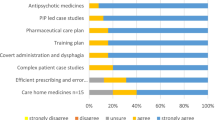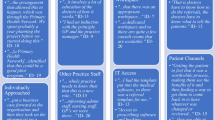Abstract
Objective
To investigate the views and experiences of pharmacists in England before and after they registered as supplementary prescribers.
Method
Eight pharmacists were recruited from training courses; seven from secondary care and one from primary care and interviewed during training and again after registration. In the first interviews, topics included previous experience, views on current roles, responsibilities and accountability for prescribing and how these might change. In the second interviews, the pharmacists discussed how these had actually changed after gaining supplementary prescribing authority, how their role worked in practice and how they saw it developing in the future.
Main outcome measure
Descriptions of anticipated and actual changes in their roles, responsibilities and accountability before and after registration as supplementary prescribers
Results
The pharmacists anticipated that training would legitimise their current ‘informal’ prescribing practices, with increased legal responsibility and accountability, but experienced many procedural delays in implementing their new role. Pharmacists who were already heavily involved with prescribing were more likely to work as prescribers, but not necessarily within the clinical management plan framework. The desire to maintain the efficiency of their existing clinical services impacted negatively on the pharmacists’ ability or willingness to prescribe in this legally approved manner.
Conclusion
Clear and realistic expectations need to be set by the pharmacists as to what is achievable and greater attention needs to be paid to minimising delays between the end of training and the beginning of practice, to minimise reduction in motivation and redeployment of staff.
Similar content being viewed by others
References
DHSS. Neighbourhood nursing: a focus for care. Report of the community nursing review. Chair: Mrs Julia Cumberlege. London: HMSO; 1986.
Review Team for Prescribing Supply and Administration of Medicines. Review of Prescribing, Supply and Administration of Medicines, Final Report. London: Department of Health; 1999.
Department of Health. Supplementary prescribing by nurses and pharmacists within the NHS in England. A guide for implementation. London: The Stationary Office; 2003.
Wilson P. The development of a curriculum for supplementary prescribing. Pharm J 2003;270:21–2.
Farrell J, North-Lewis P, Cross M. Pharmacist prescribing in the United States. Pharm J 1997;259:187–90.
American College of Clinical Pharmacy. Collaborative drug therapy management by pharmacists – 2003. Pharmacotherapy 2003;23(9):1210–25.
Tully MP, Seston EM. The impact of pharmacists providing a prescription review and monitoring service in ambulatory care or community practice. Ann Pharmacother 2000;34:1320–31.
Jenkins D, Cairns C, Barber N. How do ward pharmacists spend their time? an activity sampling study. Int J Pharm Pract 1992;1:148–51.
Barrett JM, Hebron B. An examination of the impact of a ward-based pharmacist on the ability of a diabetes medical ward to cope with winter pressures. Pharm J 2002;268:28–31.
Hobson R, Sewell G. UK survey of discharge prescriptions, transcribing and development of the hospital pharmacist-prescribing role. Int J Pharm Pract 2002;10(supplement):R12.
Tomlin M. A year in the life of a supplementary prescriber. Hospital Pharmacist 2005;12:182–3.
Loveland P. The New Deal: an account of progress in reducing junior hospital doctors’ hours in England. Health Trends 1992;24(1):3–4.
Department of Health. Pharmacy in the future: implementing the NHS Plan. London: The Stationary Office; 2000.
Department of Health. The NHS Plan: a plan for investment, a plan for reform. London: The Stationary Office; 2000.
Lloyd F, McHenry L, Hughes CM. Views of junior house officers/senior house officers on pharmacist supplementary prescribing. Int J Pharm Pract 2005;13(Suppl):R96.
Centre for Pharmacy Postgraduate Education. Supplementary prescribing: legal, policy, professional and ethical aspects. Manchester: CPPE; 2004.
Anon. The Department of Health’s view. Hospital Pharmacist 2003;10:484–5.
Elfellah M, Hillis G, Jappy B. Supplementary prescribing can be adapted to improve discharge planning. Pharm J 2005;274:338.
Bond C, Matheson C, Williams S, Williams P, Donnan P. Repeat prescribing: a role for community pharmacists in controlling and monitoring repeat prescriptions. Br J Gen Pract 2000;50:271–5.
Rupp MT, De Almentero DR, Dion P. Value of community pharmacists’ intervention to correct prescribing errors. Ann Pharmacother 1992;26:1580–4.
Bates DW, Leape LL, Cullen DJ, Laird N, Petersen LA, Teich JM, et al. Effect of computerized physician order entry and a team intervention on prevention of serious medication errors. JAMA 1998;280:1311–6.
Parker D, MaPSaF Team. Manchester Patient Safety Framework (Acute). Manchester: University of Manchester and National Patient Safety Agency; 2006.
Weiss MC, Sutton J, Adams C. Exploring innovation in pharmacy practice: A qualitative evaluation of supplementary prescribing by pharmacists. Bath: University of Bath; 2006.
George J, McCaig DJ, Bond CM, Cunningham IT, Diack HL, Watson AM, et al. Supplementary prescribing: early experiences of pharmacists in Great Britain. Ann Pharmacother 2006;40(10):1843–50.
Luker K, McHugh G. Nurse prescribing from the community nurse’s perspective. Int J Pharm Pract 2002;10:273–80.
Hall J. Can we learn from nurse prescribing? Pharm J 2004;272:56.
Timbs O. Leading article: Confidence and competence. Pharm J 2005;274:2.
Acknowledgements
We would like to thank all the supplementary prescribing pharmacists who agreed to take part in the study. We would also like to thank Ms Sharon Phul, who conducted some of the early interviews. This study was funded by the Research Support Fund of the University of Manchester.
Author information
Authors and Affiliations
Corresponding author
Rights and permissions
About this article
Cite this article
Tully, M.P., Latif, S., Cantrill, J.A. et al. Pharmacists’ changing views of their supplementary prescribing authority. Pharm World Sci 29, 628–634 (2007). https://doi.org/10.1007/s11096-007-9114-2
Received:
Accepted:
Published:
Issue Date:
DOI: https://doi.org/10.1007/s11096-007-9114-2




